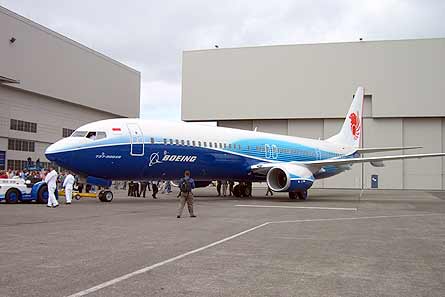By Guy Norris in Seattle
Boeing voices confidence in newly rolled-out variant of twinjet, hoping it will offer better 'real world' performance
Boeing is optimistic that imminent flight tests of the newly rolled out 737-900ER will demonstrate better than guaranteed performance, allowing operators to use the aircraft year-round on longer-range flights including the most demanding transcontinental US routes.
Although designed to take up to 215 passengers in its maximum exit-limited seat configuration, one of the aircraft's key markets is seen as the 180-seat sector, where it competes against the Airbus A321. Boeing originally estimated the -900ER would fly up to 5,220km (2,820nm) with 180 passengers in two-class seating, without the optional provision of two auxiliary fuel tanks, compared with the A321's 4,290km range capability with 183 passengers under the same conditions.
Although adequate for most requirements, Boeing admits the current range specification for the 737-900ER means some longer-range transcontinental routes such as Florida-Seattle with winter winds will be "a challenge". It therefore hopes that flight tests will demonstrate a better "real-world" performance, mostly from weight and engine improvements.
The company's optimism stems partly from a weight check completed just before roll-out at Boeing's Renton site on 8 August, which revealed "we are under weight for our target", says 737-900ER deputy programme manager Patrick Schirmer.
|
|---|
| The Boeing 737-900ER will be put through a five-month test programme ahead of service entry early next year |
The weight advantage is expected to give around a 90km improvement, "so we're confident we'll meet all of our guarantees right now", he says.
Although yet to be officially confirmed, the updated range of the aircraft, with 180 passengers and the same overall operating assumptions as before, is expected to be around 5,320km without extra tanks and 6,000km with two optional fuel tanks.
Flight tests, which are set to start on 7 September, will verify the exact performance of the aircraft with the revised configuration that includes the short-field enhancement package of slat, flap, brake and tailskid improvements. From December, the aircraft will also be flying with the newly installed CFM56-7B Tech Insertion engines that are expected to yield some fuel burn benefits as well as longer life on wing and higher temperature margins.
"Trans-con is a bit 'nip-and-tuck', particularly in the winter, so every bit counts," says Schirmer, who adds that the better-than-expected weight result on the new aircraft already represents a competitive advantage.
The improved result stemmed from overly conservative weight estimates of the revised aft fuselage,short-field enhancement package and main landing gear.
"The wing also came in a bit lighter than was thought. Flutter requirements didn't turn out to be an issue and there's no ballast in this wing," he adds. "I'm now asking the weight team for a better estimate, and we could have guaranteed better range."
A second aircraft is due to join the flight-test campaign in late October, with type and production certification expected in mid-February 2007.
First deliveries to launch customer Lion Air of Indonesia are expected around April.
Source: Flight International
























